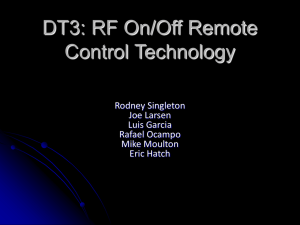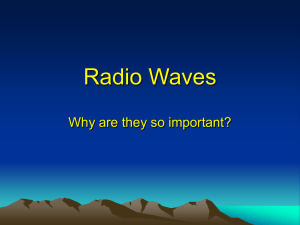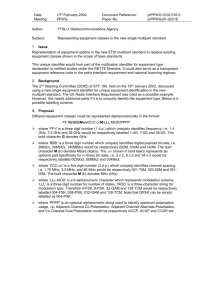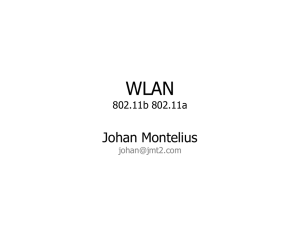CABB user requirements
advertisement
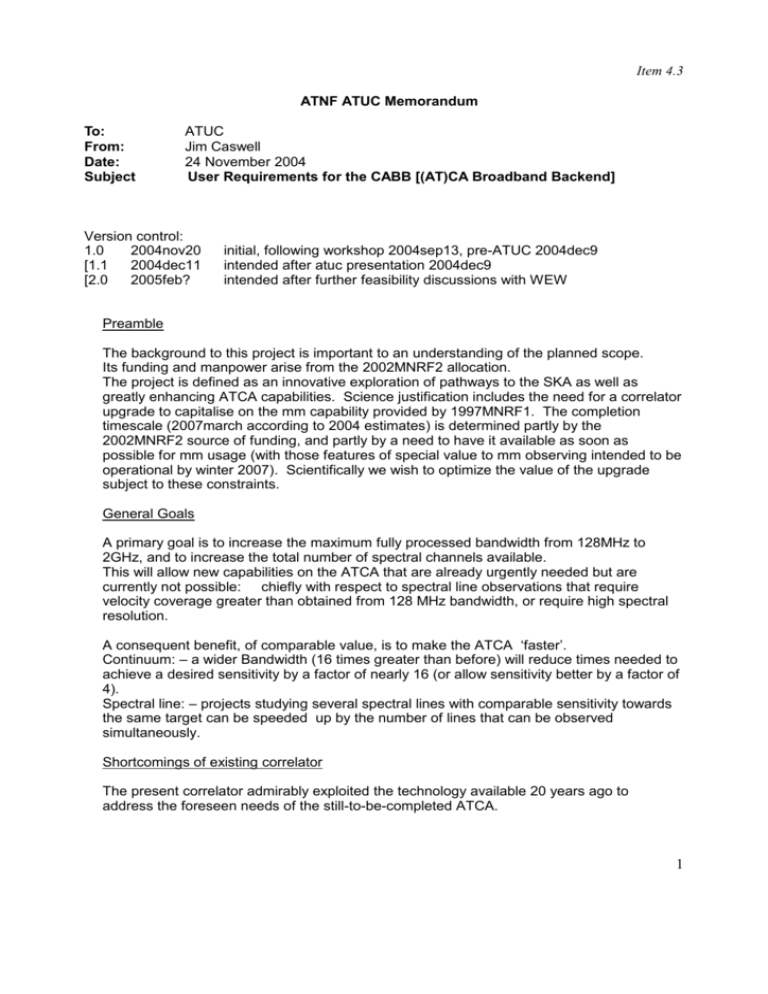
Item 4.3 ATNF ATUC Memorandum To: From: Date: Subject ATUC Jim Caswell 24 November 2004 User Requirements for the CABB [(AT)CA Broadband Backend] Version control: 1.0 2004nov20 [1.1 2004dec11 [2.0 2005feb? initial, following workshop 2004sep13, pre-ATUC 2004dec9 intended after atuc presentation 2004dec9 intended after further feasibility discussions with WEW Preamble The background to this project is important to an understanding of the planned scope. Its funding and manpower arise from the 2002MNRF2 allocation. The project is defined as an innovative exploration of pathways to the SKA as well as greatly enhancing ATCA capabilities. Science justification includes the need for a correlator upgrade to capitalise on the mm capability provided by 1997MNRF1. The completion timescale (2007march according to 2004 estimates) is determined partly by the 2002MNRF2 source of funding, and partly by a need to have it available as soon as possible for mm usage (with those features of special value to mm observing intended to be operational by winter 2007). Scientifically we wish to optimize the value of the upgrade subject to these constraints. General Goals A primary goal is to increase the maximum fully processed bandwidth from 128MHz to 2GHz, and to increase the total number of spectral channels available. This will allow new capabilities on the ATCA that are already urgently needed but are currently not possible: chiefly with respect to spectral line observations that require velocity coverage greater than obtained from 128 MHz bandwidth, or require high spectral resolution. A consequent benefit, of comparable value, is to make the ATCA ‘faster’. Continuum: – a wider Bandwidth (16 times greater than before) will reduce times needed to achieve a desired sensitivity by a factor of nearly 16 (or allow sensitivity better by a factor of 4). Spectral line: – projects studying several spectral lines with comparable sensitivity towards the same target can be speeded up by the number of lines that can be observed simultaneously. Shortcomings of existing correlator The present correlator admirably exploited the technology available 20 years ago to address the foreseen needs of the still-to-be-completed ATCA. 1 Item 4.3 With over 15 years of operational experience, and several upgrades to the ATCA receiver suite, users now desire several modes of operation that are not possible with the present correlator. Here we enumerate four varieties of observation that are currently not possible: 1. Modest number of channels, BUT large BW > 128 MHz. e.g. CO in other galaxies requires only 2x256 channels, 2 polarizations BUT at least 512 MHz (1200 km/s). 2. Modest number of channels BUT confined to SMALL BW < 4 MHz (and thus requiring tuning more precise than the available 1 MHz precision) e.g. Galactic HI absorption 2048 channels but confined to a precisely centred BW of 1 MHz (180 km/s). 3. Modest BW within current range, and modest channel number, BUT several simultaneous spectra; e.g. two ammonia transitions. 4. Modest BW within current range, BUT large number of channels (e.g. 8192) and full Stokes (processing several simultaneous spectra, although not vital, is highly desirable to reduce observing time); e.g. OH masers at 1665, 1667, 1612 and 1720 MHz. The envisaged correlator architecture The current engineering concept envisages 4 GSample/sec, 6-bit (min.) sampler/digitisers, an FX correlator architecture and Digital Filter Banks. From this concept, the design parameters that appear to be achievable include: Sampling 2 frequencies, each with 2 polarisations, over a 2 GHz maximum bandwidth Large range of smaller bandwidths selectable within this 2 GHz 2048 channels for each spectrum on all 4 Stokes parameters 6 'station' inputs from ATCA; plus 2 additional inputs with BW capability perhaps less than 2 GHz, but at least 0.5 GHz. For comparison, readers are recommended to compare the specifications with those envisaged for the eVLA correlator as given on the NRAO website in the following major documents: 1. Specification summary in NSF proposal 2000nov 2. Requirements dictated by specific astronomical projects (see Rupen 1997). Relative to the ATCA correlator, the scope, cost and timescale for the eVLA correlator are several times larger, and it is expected to fill the VLA needs for well over a decade. In contrast, the more modest scale of the ATCA correlator, in conjunction with rapid developments in the relevant engineering technology, suggest that over the next 20 years, it would be reasonable to expect at least one, and possibly two, replacement innovative correlator designs for the ATCA, perhaps again used as validation of SKA concepts. Specific capabilities that are expected from the CABB We anticipate that the 2-GHz BW 'continuum' with 2048 channels of 1 MHz at each IF is available in all configurations, additional to higher resolution zooming for several small portions of the band. However, when zooming in on band portions of x MHz, the subdivision of the continuum may be limited to 2048/x channels. We anticipate that the several zoom regions can be independently located with precision better than x/16 MHz within the available 2GHz. Following are some specific capabilities that are expected from the CABB. Achieving these extreme ones (some of them at the borderline of achievability) will imply the availability of many (less demanding) alternative configurations. These can be assessed after the engineering solutions to the difficult requirements have been explored in detail, with regard to required processing power and some aspects of the architecture. 2 Item 4.3 1. Basic processing will sample (as for the present correlator) 2 frequencies that are 'independent' subject to the constraint that the bands to be processed lie within an 8 GHz range and, of course, limited to the frequency range of the feed horn selected. Sampling of both orthogonal polarizations will then output spectra of the 4 polarization products at each frequency. At each frequency, the available BW will be 2 GHz (compared to 128 MHz from present correlator) and each spectrum will be subdivided into 2048 channels (compared with 32 for present correlator). As noted in Appendix A, this basic mode surpasses the old correlator not only in its wider bandwidth for continuum work, but also narrower channels which ensure that there is negligible beam/bandwidth smearing in widefield imaging, or in low frequency Faraday rotation studies. As noted in Appendix B, this basic 'continuum' mode is actually a powerful spectral line capability for extragalactic work near 100 GHz (mm wavelengths) and in the 16-26 GHz band. 2. Several simultaneous spectral line observations of high spectral resolution. An example will be a capability to observe at 4 frequency locations within an IF, at each location yielding a band of 1 MHz with 2048 channels on each of the 4 polarization products. (Simultaneously we expect to have the same capability in the other IF). See Appendix C for scientific applications. 3. Small channel separation but large velocity coverage. Example: 32 MHz with 1024 channels (full Stokes). See Appendix D 4. Several parts of full band with small channel separation; modest velocity coverage. It would be useful to have as many as 8 spectra within a 2 GHz band, each covering 16 MHz and 1024 channels (8 MHz with 512 channels might be acceptable). Ideally, spectra with different specifications would also be available from the other IF. If these requests are too demanding, then a more modest request would be to obtain 4 spectra from each IF. Examples making use of this correlator configuration are given in Appendix E 5. Many parts of full band with modest channel separation; modest velocity coverage. This is a situation where the 'continuum' band has resolution slightly too poor for the spectral line investigation. For example we may require in each IF at least three spectra with BW of 32 MHz, each with 256 channels. Simultaneously we may require another spectrum of the same BW but with 2048 channels if this can be achieved. See Appendix F. 6. The above series of example configurations is expected to cover the needs at mm wavelengths of parallel observations of several spectral lines at high velocity resolution, and searches for extragalactic lines that have been redshifted into either the mm band, or the 16-26 MHz band. 7. Capabilities for pulsars and transients. Binning capabilities at least equal to those of the present correlator will be offered. More demanding specifications that will be aimed for include: (i) for 'standard' imaging, 512 MHz BW, 2048 channels, and up to 128 time bins of width as small as 60 microsec. (ii)Timing with tied array: 512 MHz, 16384 channels, 1024 time bins of width as small as 20 microsec 8. Interference mitigation: operating with high time resolution (as for pulsars) and with capability of blanking; also likely to make use of autocorrelations, and of the additional 2 3 Item 4.3 correlator inputs that may be fed from interference monitoring antennas. Detailed consideration is needed as to how the on-line characterizing of interference by the interference monitors can be used to cancel or suppress interference received by the main antennas. 9. Use of the CABB as the VLBI correlator. Future fast links will allow real time VLBI, and it seems likely that the CABB will 'double' as the VLBI correlator (whenever ATCA is part of a VLBI array). Some requirements unique to VLBI may need separate funding resources and development, but the CABB correlator needs to be compatible with these. Desire ATCA in tied array operation PLUS availability of inputs for other stations. 6 input stations will present no problem. When more are required, this could be solved if the inputs of the 2nd frequency are reconfigurable as additional station inputs. Large geometric delays (up to 22msec) and high fringe rates (up to 35 kHz during 22 GHz) must be dealt with. Tied array operation. Investigate possible support of multiple pointing centres. Require the ATCA tied array output as circular polarizations with good polarization purity over wide bandwidth. 4 Item 4.3 APPENDICES Appendix A Continuum imaging. All 4 stokes, and sufficient channels to allow widefield imaging, and (a more demanding criterion at low frequencies) minimal Faraday rotation smearing. e.g at 1200 MHz, need ch separation < 4MHz for widefield, but this would give rotation between channels of 30deg if RM=1000rad/sqm; thus 1 MHz channel width would be preferred. Above 16 GHz (20 GHz & 100 GHz; & 45 GHz eventually) Up to 2 GHz BW with 2 separate IFs allows 2x2 = 4 GHz; Will be able to use 4 GHz (2 x 2 GHz), contiguous or separated Below 10 GHz Although 2 separate IFs allow 2x2 = 4 GHz in principle, currently (until new frontend system) not contiguous; not full 2 GHz: one at L (1.2-1.7GHz), one at S (2.25-2.65 GHz); or one at C (4.4-6.4GHz) and one at X (8.0-9.2 GHz). Appendix B Spectral Line project at high frequencies with modest resolution, but large velocity coverage; if velocity coverage corresponds to 2 GHz, this yields simultaneous sensitive continuum observations. At 100 GHz, 2 GHz = 6000 km/s; 2048ch gives sep 3 km/s and is suitable for extragalactic CO observations. (current limitation is 128 MHz = 375km/s, with 64channels giving separation 6 km/s) Full band (continuum) with 2048 channels is also suitable for Hydrogen recombination line data in parallel. Note that above 85 GHz, recombination lines H42,H41,H40alpha are at 85688, 92034, and 99022 MHz, so separation exceeds 6 GHz allowing only a single line in a 2 GHz band. However since the adjacent line is separated less than 8 GHz, it will be possible to observe it in the second IF. Scientific use includes using recombination line strength relative to continuum to discriminate between thermal dust (no line) and ionized Hydrogen. This mode also allows 'blind' searches for redshifted CO (for example), using a total of 2x2 GHz and a spectral resolution of 1 MHz. Appendix C Four Stokes, and sufficient channels for narrow lines, but modest velocity coverage. Between 1.4 to 1.7 GHz GHz lie transitions of H at 1420 MHz, and OH at 1612, 1665, 1667 and 1720 MHz. OH masers minimum requirement is channel spacing 0.1 km/s (0.5 kHz) e.g. 1024 channels within BW 0.5 MHz (90 km/s) or 2048 over 1 MHz. So the 4 OH lines could be observed in one IF and the HI line in the other IF. Appendix D Small channel separation but large velocity coverage. 5 Item 4.3 22.235 GHz Galactic water masers; 32 MHz gives 432 km/s (using data right to edge of band). Masers need channel separation of 0.5 km/s or less, and all 4 Stokes parameters are desired (linear polarization is common). [Extragalactic searches are better conducted with larger collecting area, e.g. Tidbinbilla 70m; and follow up requires VLBI. However a possible useful mode with the ATCA would be to have 128 MHz with 4096 channels, perhaps achieved by using 4 adjacent spectra each covering 32 MHz and 1024 channels.] Appendix E Several parts of full band with small channel separation; modest velocity coverage. 16 to 26 GHz (current limitation to 25.3-GHz is imposed by cal and will be remedied) Ammonia lines – several simultaneously so as to ensure correct relative calibration. Need high spectral resolution (to resolve hyperfine structure. Modest velocity coverage is adequate if target properties are already explored, but wider if conducting survey (e.g. in Galactic centre). Lines 11, 22 at 23694, 23722 (useful together) and 55, 66 at 24533, 25056 (useful together); also 77 at 25715 and 33, 44 at 23870, 24532 MHz. All seven within 2 GHz, so perhaps simultaneous, each covering 8 MHz (100 km/s at 25 GHz), each 512 channels If surveying, may need at least 16 MHz, and ideally water and continuum in parallel (see previous example) Above shows observations usefully done in parallel with wideband continuum, recombination lines (if sufficiently strong) and/or at least two ammonia transitions (with less coverage of velocity satisfactory). 5. Appendix F Many parts of full band with modest channel separation; modest velocity coverage. 16 to 25 (26 eventually?) GHz Recombination lines H73-64alpha at 16563, 17258, 17992, 18769, 19591, 20461, 21384, 22364, 23404, 24509 MHz. Properties vary slowly with frequency, so they all require similar integration time; thus 5 lines simultaneously would be 5 x faster!!. NB feasible extent of galactic plane survey depends on speed. If IF1 is 17-19, get H72,H71,H70; and IF2 is 21-23, get H67,H66 plus water at 22235 MHz; would like each to have BW 32 MHz(= 432 km/s); Nchan 256, except water 2048. 6


